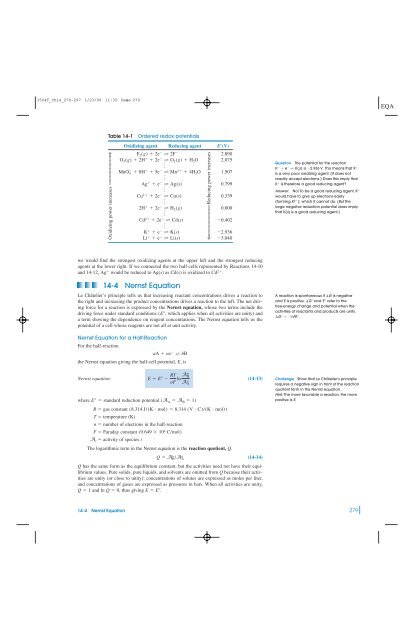Fundamentals of Electrochemistry - W.H. Freeman
Fundamentals of Electrochemistry - W.H. Freeman
Fundamentals of Electrochemistry - W.H. Freeman
You also want an ePaper? Increase the reach of your titles
YUMPU automatically turns print PDFs into web optimized ePapers that Google loves.
1504T_ch14_270-297 1/23/06 11:35 Page 279<br />
Table 14-1<br />
Ordered redox potentials<br />
Oxidizing power increases “““““““1<br />
Oxidizing agent Reducing agent E(V)<br />
F 2 (g) 2e T 2F <br />
O 3 (g) 2H 2e T O 2 (g) H 2 O<br />
2.890<br />
2.075<br />
o<br />
MnO 4 8H 5e T Mn 2 4H 2 O 1.507<br />
o<br />
Ag e T Ag(s)<br />
0.799<br />
o<br />
Cu 2 2e T Cu(s)<br />
0.339<br />
o<br />
2H 2e T H 2 (g)<br />
0.000<br />
o<br />
Cd 2 2e T Cd(s)<br />
0.402<br />
o<br />
K e T K(s)<br />
2.936<br />
Li e T Li(s)<br />
3.040<br />
B“““““““ Reducing power increases<br />
Question The potential for the reaction<br />
K e T K(s) is 2.936 V. This means that K <br />
is a very poor oxidizing agent. (It does not<br />
readily accept electrons.) Does this imply that<br />
K is therefore a good reducing agent?<br />
Answer: No! To be a good reducing agent,<br />
would have to give up electrons easily<br />
(forming K 2 ), which it cannot do. (But the<br />
large negative reduction potential does imply<br />
that K(s) is a good reducing agent.)<br />
K <br />
we would find the strongest oxidizing agents at the upper left and the strongest reducing<br />
agents at the lower right. If we connected the two half-cells represented by Reactions 14-10<br />
and 14-12, Ag would be reduced to Ag(s) as Cd(s) is oxidized to Cd 2 .<br />
14-4 Nernst Equation<br />
Le Châtelier’s principle tells us that increasing reactant concentrations drives a reaction to<br />
the right and increasing the product concentrations drives a reaction to the left. The net driving<br />
force for a reaction is expressed by the Nernst equation, whose two terms include the<br />
driving force under standard conditions (E°, which applies when all activities are unity) and<br />
a term showing the dependence on reagent concentrations. The Nernst equation tells us the<br />
potential <strong>of</strong> a cell whose reagents are not all at unit activity.<br />
A reaction is spontaneous if G is negative<br />
and E is positive. G° and E° refer to the<br />
free-energy change and potential when the<br />
activities <strong>of</strong> reactants and products are unity.<br />
G° nFE°.<br />
Nernst Equation for a Half-Reaction<br />
For the half-reaction<br />
aA ne T bB<br />
the Nernst equation giving the half-cell potential, E, is<br />
Nernst equation: E E° RT<br />
(14-13)<br />
nF ln A b B<br />
where E° standard reduction potential (A A A B 1)<br />
R gas constant (8.314 J/(K mol) 8.314 (V C)/(K mol))<br />
T temperature (K)<br />
n number <strong>of</strong> electrons in the half-reaction<br />
F Faraday constant (9.649 10 4 C/mol)<br />
A i<br />
activity <strong>of</strong> species i<br />
The logarithmic term in the Nernst equation is the reaction quotient, Q.<br />
Q A b B/A a A<br />
(14-14)<br />
Q has the same form as the equilibrium constant, but the activities need not have their equilibrium<br />
values. Pure solids, pure liquids, and solvents are omitted from Q because their activities<br />
are unity (or close to unity); concentrations <strong>of</strong> solutes are expressed as moles per liter,<br />
and concentrations <strong>of</strong> gases are expressed as pressures in bars. When all activities are unity,<br />
Q 1 and ln Q 0, thus giving E E°.<br />
A a A<br />
Challenge Show that Le Châtelier’s principle<br />
requires a negative sign in front <strong>of</strong> the reaction<br />
quotient term in the Nernst equation.<br />
Hint: The more favorable a reaction, the more<br />
positive is E.<br />
14-4 Nernst Equation 279

















